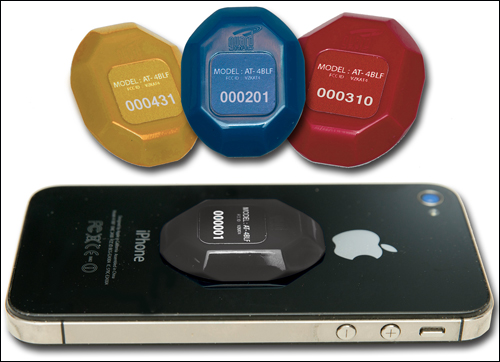Guard RFID Solutions (also known as GuardRFID) is marketing a 6-millimeter-thick active 433 MHz tag that it claims is the lowest-profile active tag currently available on the market. The tag was designed at the request of a customer in the aerospace industry that required an active tag small enough to be attached to cell phones, according to Zahir Abji, GuardRFID’s president and CEO. That customer piloted the new tag with GuardRFID’s software and readers.
GuardRFID’s active tags are used to track individuals and assets in real-time location system (RTLS) applications, by beaconing at preset intervals, or when excited by a low-frequency (LF) transmitter. Last year, Abji says, an aerospace customer approached GuardRFID with a unique problem to solve. Because the work being performed at that facility was highly sensitive, staff members or contractors entering specific areas were required to leave their mobile phones in a locker or other location outside the secured area. In this way, he explains, the company and its customers could be assured that no one could take a picture or send data to another party regarding work-in-progress.

However, ensuring that personnel do not forget this rule and inadvertently carry their phone into the secured area was difficult without reminders or officer-conducted searches. The company tried attaching a passive ultrahigh-frequency (UHF) RFID label to each phone, but found that the tags were not always read, especially depending on the orientation of the phone’s tag within an individual’s pocket or bag. In addition, passive tags require an array of antennas around a door that could be deemed aesthetically problematic. Active tags, including GuardRFID’s existing active RFID tags, tend to be too thick—about a half inch or more in height—to attach to a phone.
To address this problem, GuardRFID’s engineers developed a new tag, known as the Article Tag or Active Label (AT-4BLF), that comes with a battery, a motion sensor and a temperature sensor. The tag, which measures 1.56 inches by 1.26 inches in length and width, can be affixed to the back of a cell phone via adhesive. The built-in motion sensor enables the tag to beacon more frequently when the object to which it is attached is moving, but less often when stationary, thereby extending the battery life (which is estimated at 12 months with 60 percent motion, and at 24 months with 5 percent motion). The tag can also be used in security applications for objects that should never be moved—for example, the GuardRFID software can be configured to issue an alert to management in the event that such an object begins moving. The temperature sensor, though not utilized in the aerospace application, would enable users to track temperature conditions within such environments as refrigerators or freezers, Abji says.
According to Abji, GuardRFID’s engineers achieved the tag’s low profile by adjusting the antenna design, though he declines to provide specific details about that design. The company developed three prototypes of the tag prior to creating the version it is now marketing, he says. The tag’s read range, he says, is the same range as that of other active tags of greater size: up to 150 feet with no obstructions or, more typically, 80 feet indoors.
For the aerospace company, GuardRFID installed an LF 125 kHz exciter and a 433 MHz reader in the ceiling above two doors allowing access to a secured area. GuardRFID also provided an audio device by each door that could sound an alert when necessary. The RTLS firm modified its infant-protection software for the application, and ran that software onsite in order to collect and interpret read data, as well as store that information for historical records. That data could then be reviewed or shared, Abji explains—for example, with the U.S. Department of Defense, if the agency wished to view records proving that smartphones did not enter a specified area.
If an individual forgot to remove a phone from his or her pocket upon entering through the door, the exciter awakened the phone’s tag, which began transmitting its ID number via a proprietary air-interface protocol. The reader received that ID and forwarded it to the software, which not only stored that event data but also triggered an alarm to be sounded by the doorway’s audio device, thereby reminding the individual to remove his or her phone and store it outside the secured area.
Following a pilot of the technology, the aerospace company is now considering whether to permanently install the solution. In the meantime, Abji reports, GuardRFID is in discussions with several potential customers in other industries. For example, he says, several health-care facilities are interested in using GuardRFID’s RTLS solution, with the low-profile tags, to track thermometers and other small equipment. Such small items do not lend themselves to active tagging, since active tags are often too large to be attached, or too cumbersome if joined to the device as a hangtag. In industrial environments, Abji notes, the low-profile active tag could be used to track metal tools or other small equipment within a manufacturing or industrial facility. Additionally, the tag could be placed in hardhats to track personnel for safety purposes. He says schools are also interested in using the tags for tracking students—the tag could be attached to a backpack, and thus enable a school to identify each child’s location in real time.
For use on phones, the tag is also designed to minimize any potential for interference from a phone’s own signal. GuardRFID accomplished this goal, Abji says, through the receiver design, antenna and communication protocol. “Any radio frequency-based device,” he states, “is susceptible to disruption if a foreign radio signal with enough power is put in its vicinity.” With that in mind, “it can never be claimed that a radio-based system is not susceptible to radio noise at any level, and we do not claim that either.” However, he adds, GuardRFID’s products “are strongly resistant to radio noise.”


